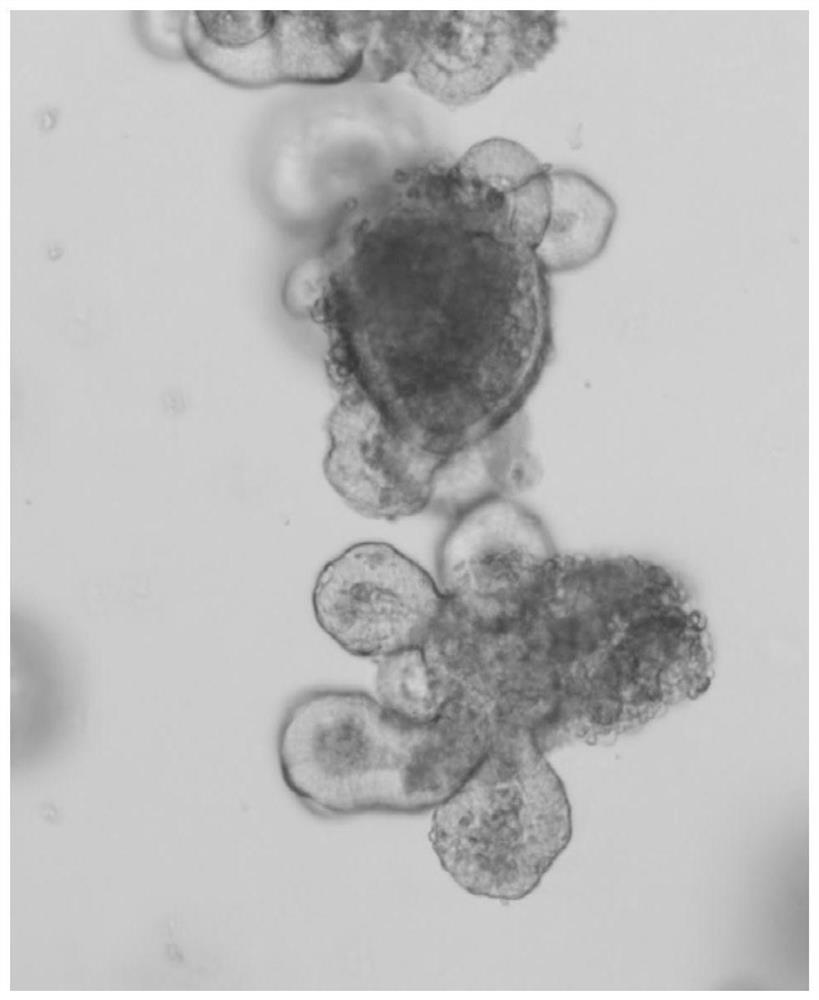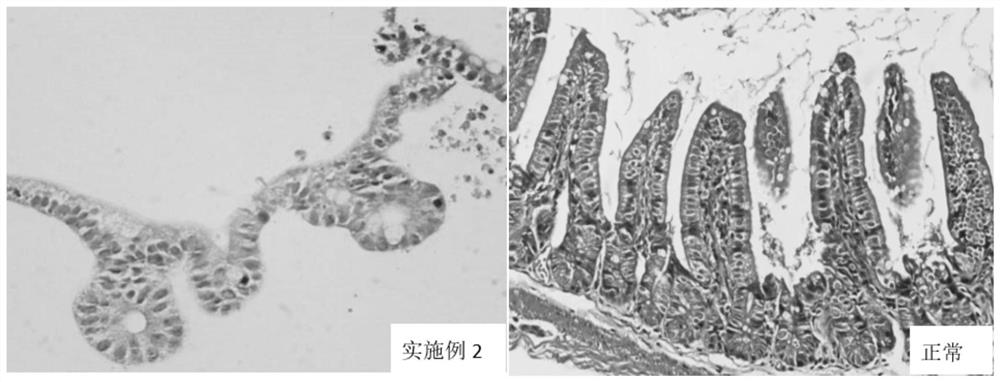Low-cost mouse intestinal organ culture medium and culture method
A culture method and culture medium technology, applied in the field of cell biology, can solve the problem of less mouse intestinal organoids, etc., and achieve the effects of low cost and convenient production
- Summary
- Abstract
- Description
- Claims
- Application Information
AI Technical Summary
Problems solved by technology
Method used
Image
Examples
Embodiment 1
[0055] A mouse intestinal organoid medium comprising the following components:
[0056] DMEM / F12 medium: 90%;
[0057] 293T-HA-Rspo1-Fc cell supernatant: 5%;
[0058] Vitamin A-free B27 additive: 2%;
[0059] Acetyl cysteine amide 0.2μmol / L;
[0060] Prostaglandin E2 0.1μmol / L;
[0061] Mouse epidermal growth factor 10ng / mL;
[0062] Selective small molecule inhibitor A83-01 1μmol / L;
[0063] ROCK inhibitor Y27632 5 μmol / L;
[0064] Gastrin I 5ng / mL;
[0065] Penicillin: 100U / mL;
[0066] Streptomycin: 100 μg / mL;
[0067] Amphotericin B 0.5 μg / mL.
[0068] A method for culturing mouse intestinal organoids is as follows:
[0069] (1) Take fresh mouse intestines for pretreatment to obtain a cell mass of 3 cells, centrifuge to remove the supernatant, and obtain a cell mass precipitate;
[0070] (2) Take an appropriate amount of the above medium and mix it with Matrigel, then use the mixture to resuspend the cell pellet obtained in step (1), and then use a pipette to dr...
Embodiment 2
[0075] A mouse intestinal organoid medium comprising the following components:
[0076] DMEM / F12 medium: 70%;
[0077] 293T-HA-Rspo1-Fc cell supernatant: 25%;
[0078] Vitamin A-free B27 additive: 4%;
[0079] Acetyl cysteine amide 2μmol / L;
[0080] Prostaglandin E2 0.5μmol / L;
[0081] Mouse epidermal growth factor 60ng / mL;
[0082] Selective small molecule inhibitor A83-01 5 μmol / L;
[0083] ROCK inhibitor Y27632 25 μmol / L;
[0084] Gastrin I 25ng / mL;
[0085] Penicillin: 200U / mL;
[0086] Streptomycin: 100 μg / mL;
[0087] Amphotericin B 2.5 μg / mL.
[0088] A method for culturing mouse intestinal cells, comprising the following steps:
[0089] (1) Take fresh mouse intestines for pretreatment, after obtaining a cell mass with a cell number of 30 cells, centrifuge to remove the supernatant, and obtain a cell mass precipitate;
[0090] (2) Take an appropriate amount of the above medium and mix it with Matrigel, then use the mixture to resuspend the cell pellet obtai...
Embodiment 3
[0095] A mouse intestinal organoid medium comprising the following components:
[0096] DMEM / F12 medium: 85%;
[0097] 293T-HA-Rspo1-Fc cell supernatant: 5%;
[0098] Vitamin A-free B27 additive: 10%;
[0099] Acetyl cysteine amide 5μmol / L;
[0100] Prostaglandin E2 1μmol / L;
[0101] Mouse epidermal growth factor 100ng / mL;
[0102] Selective small molecule inhibitor A83-01 10μmol / L;
[0103] ROCK inhibitor Y27632 50μmol / L;
[0104] Gastrin I 50ng / mL;
[0105] Penicillin: 500U / mL;
[0106] Streptomycin: 500 μg / mL;
[0107] Amphotericin B 5 μg / mL.
[0108] A method for culturing mouse intestinal cells, comprising the following steps:
[0109] (1) Take fresh mouse intestines for pretreatment, after obtaining a cell mass with a cell number of 50 cells, centrifuge to remove the supernatant, and obtain a cell mass precipitate;
[0110] (2) Take an appropriate amount of mouse intestinal cell culture medium and mix it with matrigel, then use the mixture to resuspend the c...
PUM
 Login to View More
Login to View More Abstract
Description
Claims
Application Information
 Login to View More
Login to View More - R&D
- Intellectual Property
- Life Sciences
- Materials
- Tech Scout
- Unparalleled Data Quality
- Higher Quality Content
- 60% Fewer Hallucinations
Browse by: Latest US Patents, China's latest patents, Technical Efficacy Thesaurus, Application Domain, Technology Topic, Popular Technical Reports.
© 2025 PatSnap. All rights reserved.Legal|Privacy policy|Modern Slavery Act Transparency Statement|Sitemap|About US| Contact US: help@patsnap.com


